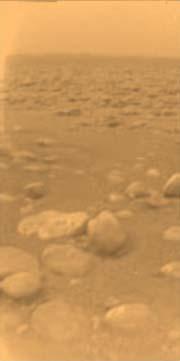 Huygens has found a hydrocarbon beach on Titan. The flat boulder in the middle of the picture is about 15 centimetres across, and lies about 85 centimetres away from the probe. The image has been tinted orange to represent the approximate colour of Titan's surface.© ESA/NASA/University of Arizona
Huygens has found a hydrocarbon beach on Titan. The flat boulder in the middle of the picture is about 15 centimetres across, and lies about 85 centimetres away from the probe. The image has been tinted orange to represent the approximate colour of Titan's surface.© ESA/NASA/University of ArizonaThe Huygens probe has sent back stunning images of Titan's surface, which have given scientists their first glimpse beneath the moon's smoggy shroud.
The pictures show an orange world littered with small rocks made of water and hydrocarbon ice, frozen at -180 °C. During the descent Huygens also saw what seemed to be drainage channels snaking towards a dark shoreline, confirming scientists' suspicions that Titan could have seas of liquid methane and ethane. White streaks in the aerial images are likely to be ground fog made of methane.
Erosion around the base of the rocks, which range from 5 to 20 centimetres across, may indicate that a liquid has flowed around them, just like the depressions around rocks on a damp beach.
The pictures were relayed to European Space Agency scientists at Darmstadt, Germany, on Friday 14 January. The first images came from a point about 16 kilometres above the surface.
Titan is about 1.2 billion kilometres away from Earth, and is the first moon other than our own to be explored. It is the only moon in the Solar System with a significant atmosphere, and is thought to have a composition similar to Earth's primitive atmosphere.
Crème brûlée
When it crashed into Titan, Huygens' rod-like 'penetrometer' encountered a relatively hard crust before sinking about 15 centimetres into the ground. This suggests that the surface has the consistency of wet sand or crème brûlée, says John Zarnecki from the Open University, Milton Keynes, UK, who is in charge of the surface science package of instruments on Huygens.
Scientists had been concerned that the scientific instruments of Huygens might not survive the impact on Titan. The force of landing could have been like "riding your bicycle into a brick wall", says Martin Tomasko, from the University of Arizona, Tucson, who is responsible for Huygens' Descent Imager.
But after a 2.5-hour descent, a soft landing allowed Huygens to continue sending signals for at least another 70 minutes after it reached Titan's surface, at 12:34 GMT.
The moon's soil seems to be a sticky tar of hydrocarbons. Huygens' mass spectrometer detected methane, ethane, acetylene and other hydrocarbons evaporating from the probe's landing site.
Phoning home
<mediar rid='m1'><?xm-replace_text {mediar}?></mediar>Huygens relayed its data to the Cassini craft passing overhead, which collected all the transmissions before turning towards Earth to beam them to NASA's Deep Space Network, a trio of powerful radio antennas based in California, Spain and Australia.
In fact, a joint effort between 18 radio telescopes around the world also managed to pick up most of Huygens' faint signals directly, even though they are only as strong as a mobile-phone transmission.
Although the mission has run almost flawlessly, there has been one set-back. Huygens was meant to send back its data along two different radio channels, but one of them failed. While most experiments were recorded on both channels, about half of the 700 expected images were lost, along with information about the winds in Titan's atmosphere. The European Space Agency is planning a full investigation to find out why some of the probe's data were lost.
The radio telescope interceptions have rescued the wind measurements, allowing scientists to reconstruct what Huygens " heard ":../multimedia/huygensdescent.mp3 as it plummeted towards the ground.
"What was impossible to even think about some years ago has become reality, thanks to advances in technology," says Leonid Gurvits, from the the Joint Institute for Very Long Baseline Interferometry in Europe, in Dwingeloo, the Netherlands.
Windy moon
Scientists have already estimated that winds were travelling about 25 kilometres per hour in Titan's atmosphere. Comparing data from all the radio telescopes will allow scientists to determine Huygens' position during its descent and landing to the nearest kilometre, adds Gurvits, although it will take longer to reconstruct the data than originally planned.
The probe's radar measured the distance to Titan's surface as it fell - the " rising sound ":../multimedia/huygensradar.mp3 can be turned into detailed information about the craft's trajectory. Further discoveries will be announced over the next few days.
Although the European Space Agency is responsible for the Huygens probe, the $3.3-billion Cassini mission is a joint project between it, NASA and the Italian Space Agency. The Cassini craft will continue sending back postcards from its tour of Saturn and its moons until at least the middle of 2008.
